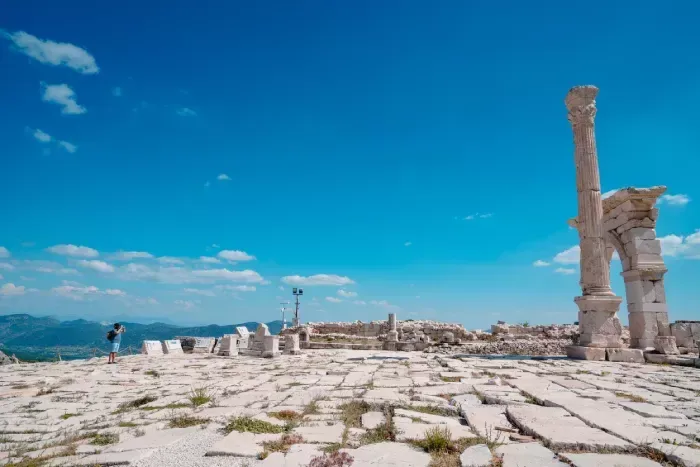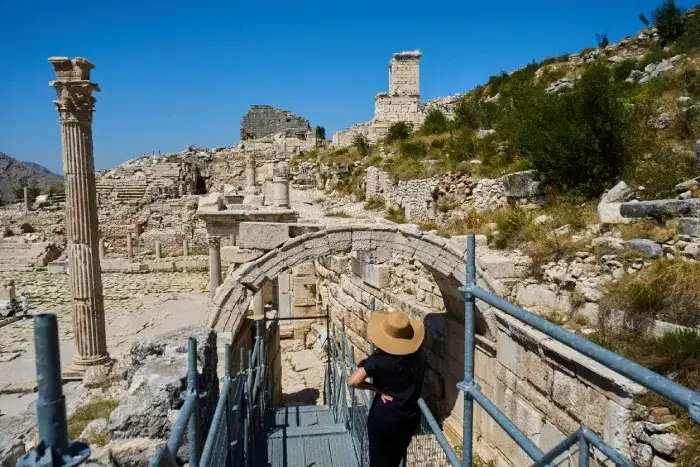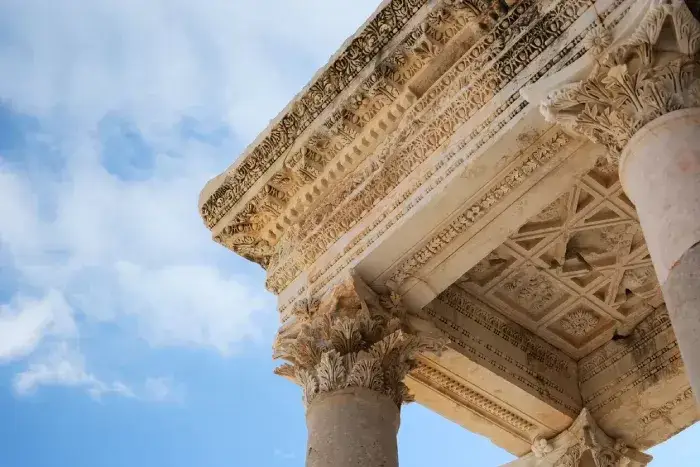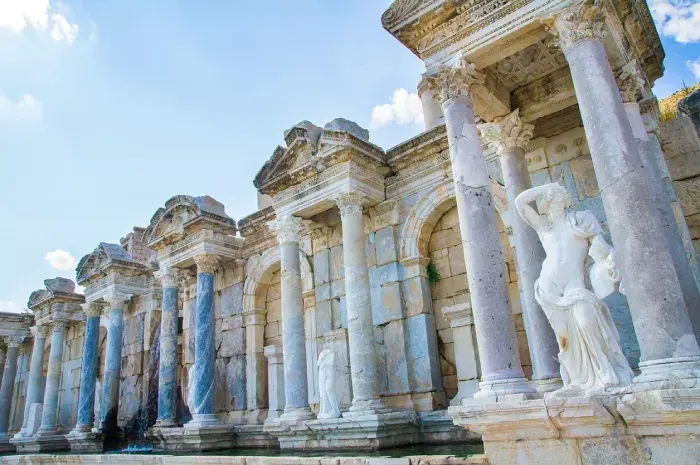Discover Sagalassos: The Hidden Turkish Ancient City
Close to Aglasun, a town of Burdur province characterized by its natural beauties, Sagalassos is known to be the first of the Pisidian cities.
After natural disasters and several unlucky events, such as the Arab raids, the ancient city of Sagalassos was deserted.
.jpg)
The western Taurus ranges of Turkey store one of antiquity's best treasures in splendorous mountains - Sagalassos. This wonderful old city claims striking heights of 1450-1700 meters, revealing itself as a treasure crown 100 kilometers north of Antalya. Time held its secrets from 8000 BCE, while true splendor arrived following the victory of Alexander the Great in 333 BCE.
Roman historians hailed Sagalassos the "first city of Pisidia," a testament to its being one of Emperor Hadrian's favorite cities. Gigantic architecture is a testament to its past grandeur - a magnificent theater holding 9,000 spectators, large imperial baths, and the beautiful Antonine Fountain with seven various colored stones. Silent centuries hid this archaeological gem from the sight of contemporary man until 1990 when extensive excavations unveiled its treasures. Every discovered monument whispers stories of its rich past, ranging from Hellenistic to Roman and early Byzantine periods.

Discovery of Sagalassos Ancient City
Summer sunlight shone upon a remarkable instance when archaeologist Marc Waelkens happened upon unscathed remains of Sagalassos. Isolation on a mountain top turned out to be nature's preservationist, erosion debris layers neatly sealing the ancient riches under.
First Modern Explorations
Astonishment greeted the initial survey party as they stood before a magnificent theater, nearly in its entirety, outstretched before them with its 9,000 seats. Temple remains speckled the horizon as ancient street grids left behind ghostly marks through centuries. Scattered artifacts blanketed the earth - glinting glass fragments, worn ceramics, and battered coins promised more to come.
Major Archaeological Findings
1990 marked the start of large-scale excavations under the guidance of Marc Waelkens of Katholieke Universiteit Leuven. Blinding discoveries were made:
- 2007 yielded a monstrous marvel - Emperor Hadrian's marble portrait 13 to 16 feet high
- Faustina the Elder head statue unveiled in 2008, amazingly preserved over centuries
- Marcus Aurelius' huge portrait head shortly afterward, forming an imperial trinity
Recent Excavation Projects
Professor Jeroen Poblome directs what is currently the Mediterranean's most extensive archaeological project. Twin agoras, a stylish Roman bathhouse, a grand city hall, and beautiful fountains have risen from their tombs in the earth. Delicate restoration work goes at lightning speed but is meticulous, taking care to adhere to historical accuracy requirements while providing valuable expertise to local artisans.
New methods define this archaeological mission. Sophisticated urban and geophysical surveys integrate with accurate territorial studies. Beyond city boundaries, recent excavations have revealed proof of human presence 150,000 years ago.

A Tour Through Ancient Sagalassos
Giant stone sentries rise from ancient Sagalassos, each edifice whispering tales of bygone greatness. These architectural jewels bear testament to masterful engineering prowess and civic prosperity.
The Grand Theater
Located majestically at 1600 meters, the grand theater dominates panoramic vistas over mountain ranges. Talented artisans constructed this marvel between 180-210 AD, seating 9,000 spectators. Historical context dictates its unique design - a single-story stage building is aligned towards the legendary hillside upon which Alexander the Great triumphed in the battle against Sagalassian forces in 333 BC. Classical Hellenistic architecture dictates its form, with an elegant horseshoe-shaped auditorium curving itself around the natural slope.
The Antonine Fountain
Roman engineering excellence permeates the Antonine Fountain built 160-180 AD. This imposing monument has:
- Eight statue niches adorn its back wall
- Breathtaking proportions measuring 28 meters long and standing 9 meters high
- Seven various colored stones mix with Afyon marble, creating dazzling light plays
Contemporary artisans gave new life to this ancient marvel by 2010, returning its waters to flow as they did 1,800 years ago. Generous patrons Titus Flavius Severianus Neon and his wife live on through this lasting testament.
The Imperial Baths
Asia Minor's Roman ancient baths stood proudly within Sagalassos. Between 10-30 AD they were constructed in their powerful form, 32.5 by 40 meters in length and rising 12 meters high - today 8.5 meters remain. Roman bath tradition excluded its construction: separate rooms held warm tepidarium, hot caldarium, and cold frigidarium pools. More sophisticated imperial baths later were constructed to enclose this complex with Hadrian converting Sagalassos to the imperial cult city of Pisidia.
Life in Ancient Sagalassos
The rich archaeology exposed here in Sagalassos brings forth enticing portraits of life within this Roman imperial city. Discoveries amply illustrate the routines of day-to-day living in the first century BC up to the seventh century AD.
Daily Routines
Sacred rituals of communal meals pervaded social life in Sagalassos. Archaeologists discovered remarkable evidence - intact dishes and overturned bowls with their ancient fare still within. Such valuable vessels originated from what scholars identify as a convention hall, where the city's residents dined in common. The religious cults and guilds were the promoters, with ancient customs tracing back from time immemorial.
Evenings were not only meals - evenings set social identity itself. Close attention to the structure of meals unmasks intricate entanglements of diet and family. Breakfast cereal filled neighborhood tables, and joint entrées reaffirmed community ties even as they established social borders.
Trade and Commerce
Six hectares of useful industry hidden over the Eastern Suburbium. The sound of workshops echoed along streets where artisans worked out their craft:
- Clay diggers dug quarries
- Stone cutters worked blocks
- Metalworkers hammered tools
- Potters made pots
- Glassmakers made fragile cups and flasks
Life throbbed in the Upper Agora, Sagalassos' commercial center. Their commerce, politics, religion, and civic obligation were entwined in day-to-day life. Centuries of architectural development point to urban life's development and communal relationships. It was more than commerce alone that this market established social relationships and civic pride, in every sense, community spirit.

Customize Your Dream Vacation!
Get in touch with our local experts for an unforgettable journey.
Plan Your TripConservation in Sagalassos Today
Mountain winds and cruel weather wage a constant battle against the ancient stones of Sagalassos. Cruel height subjects these coveted ruins to ferocious cycles of frost, wet winters, and scorching summers, relentlessly wearing away century-old structures.
Time has stripped protecting plaster and marble veneering from the foundations of stones and brick structures, leaving them open to the full fury of the natural forces. Water seeps into centuries-old masonry while freezing disintegrates mortar joints into rubble, leaving architectural ornamentations in growing danger of inexorable but cumulative deterioration.
Conservation Projects
Sophisticated conservators at KU Leuven's Sagalassos Archaeological Research Project combine ancient philosophy with modern technology. Their cutting-edge preservation methods are:
- Frost-resisting mortar compounds
- Precise 3D scanning of buildings
- Classic building techniques with modern standards included
A Visit to Sagalassos Today
A trip to Sagalassos today is to enter a living museum in which ancient history unfolds before your eyes. In the background of Turkey's Western Taurus mountains, the site offers breathtaking scenery and an awe-inspiring atmosphere of peace. As you walk through the ruins, you will be confronted with the gigantic remains of the large theater, the towering Antonine Fountain, and the remarkably preserved Roman baths.
The old pulse of the city, the Upper Agora, throbs even now with the energy of commerce and civic life. Restoration work in progress there uncovers these treasures anew, and new-age machinery and archaeological methods lend a more kinetic vision to Sagalassos' ancient past. A blue-blooded archaeology enthusiast or simply seeking an opportunity to connect with the ancient world, Sagalassos provides an experience one will never forget that is a blend of history, culture, and nature.

Ancient heritage meets modern commitment at the mountain sanctuary of Sagalassos. Quiet centuries protected this gem above the peaks of Western Taurus Turkey, but unfailing archaeological resolve now uncovers its secrets. Stunning monuments - imposing theater, Antonine Fountain, imperial baths - bear witness to past glories as skilled conservators make their voices heard by generations to come.
Heritage protectors emerge from rural life, i.e., devoted villagers of Ağlasun. Skilled hands preserve traditional practices through master classes while economic labor protects cultural treasures. Sacred rocks thus promote long-term development, connecting past achievements with future opportunities.
Roman daily life comes alive from the fondly restored ruins of Sagalassos. Simple dining halls echo with disembodied conversation and bazaar remnants identify subtle patterns of trade centuries old. Elegant restoration gives these ancient halls new life, offering genuine windows onto imperial Roman existence. Sagalassos towers tall, powerful monuments to human genius and determination across the ages.
FAQs
Q1. What was the first city of Pisidia?
Sagalassos is widely recognized as the pioneering urban center of Pisidia, a title affirmed by its historical and cultural significance in ancient texts.
Q2. What is the history of Sagalassos?
The story of Sagalassos unfolds over millennia, from its prehistorical origins to its peak as a vibrant Roman center. Today, its ruins tell a tale of evolution, resilience, and the grandeur of past civilizations.
Q3. Who built the Sagalassos fountain?
The renowned Antonine Fountain at Sagalassos was constructed by skilled Roman engineers between 161 and 180 AD, reflecting the ingenuity of the era.
Q4. What is the nearest airport to Sagalassos?
The nearest major airport is Antalya Airport, located roughly 100 kilometers from Sagalassos, serving as the primary gateway for visitors.
























































